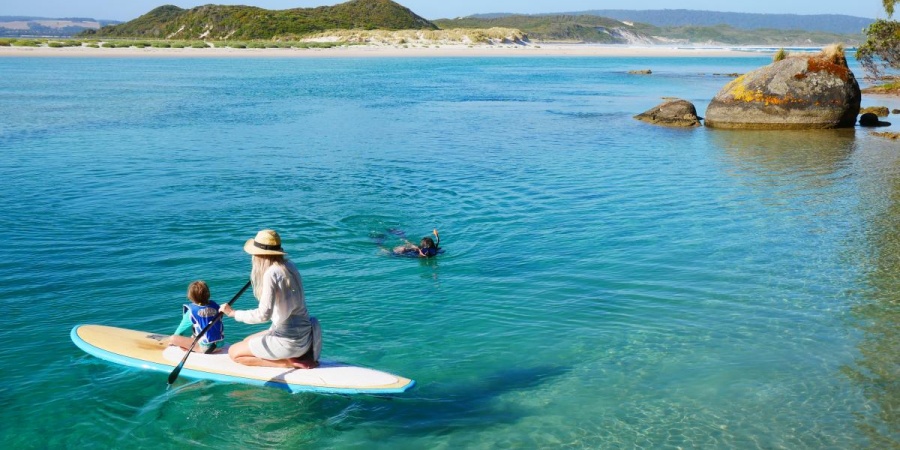
Walpole-Nornalup National Park
Marine parks are like national parks, but instead of protecting scenic landscapes or biologically important areas of land, marine parks protect scenic and biologically important areas of ocean and coastline (usually to high water mark) including:
- inshore waters
- offshore waters
- reefs
- rocky shores
- mangroves
- mudflats
- estuaries
- beaches
- islands and
- all marine plants and animals within these habitats.
Instead of fences, marine parks have floating marker buoys that indicate the position of sanctuary (no take) zones (where people can’t fish or collect other marine animals or plants) and shore based zone markers so people in boats can see where the boundaries of the park are.
There are 17 marine parks in Western Australia managed by the DBCA's Parks and Wildlife Service: Walpole and Nornalup Inlets Marine Park, Ngari Capes Marine Park, Shoalwater Islands Marine Park, Swan Estuary Marine Park, Marmion Marine Park, Jurien Bay Marine Park, Shark Bay Marine Park, Ningaloo Marine Park, Barrow Island Marine Park, Montebello Islands Marine Park, Rowley Shoals Marine Park, Lalang-garram / Camden Sound Marine Park, Eighty Mile Beach Marine Park, Yawuru Nagulagun / Roebuck Bay Marine Park, Lalang-garram / Horizontal Falls Marine Park, North Lalang-garram Marine Park and the North Kimberley Marine Park.
There are also two other types of marine conservation reserve in Western Australia. Marine nature reserves are created for conservation and scientific research. Although low-impact tourism may be permitted, they are ‘look but don’t take’ areas given the highest level of environmental protection. Hamelin Pool Marine Nature Reserve at Shark Bay is the only marine nature reserve in WA.
Marine management areas provide an integrated management structure over areas that have both high conservation value and intensive multiple use. There are two marine management areas in WA (at the Muiron Islands and Barrow Island).
What can you do in a marine park?

Kite surfing in Jurien Bay Marine Park - Photo DBCA
Marine parks are managed by the DBCA's Parks and Wildlife Service on behalf of the people of Western Australia. They cater for multiple use and have many different zones (areas of ocean set aside for a particular purpose) so you can enjoy all sorts of marine activities such as:
- snorkelling (all zones)
- scuba diving (all zones)
- surfing (all zones)
- beachwalking (all zones)
- swimming (all zones)
- boating (all zones although there may be special rules about anchoring and mooring)
- water sports like kayaking, windsurfing and canoeing (all zones)
You can usually go fishing outside designated sanctuary zones, as long as you follow size and bag limits set by the fisheries department (check what they are first). Some different types of fishing may be restricted in different zones. For instance, commercial fishing is not allowed in recreation zones and rock lobster fishing is not allowed in some special purpose zones. Each marine park in Western Australia has its own zoning scheme, so before you fish in a marine park 'Know Your Zones' and find out the rules for each zone.
Why do we need marine parks?
To protect unique marine environments
Western Australia’s coastline spans more than 13,500 kilometres and is home to some of the most amazing marine life in the world. Marine parks protect these unique marine and coastal environments and the animals and plants that live within them. For example, marine parks protect the beautiful coral reef environments of Ningaloo Marine Park, the pristine coral reef atolls at the Rowley Shoals Marine Park, the seagrass meadows of Shark Bay Marine Park and surround many islands along the coast that are important breeding and feeding grounds for sea lions, seabirds, turtles and penguins.
For future generations
Some human activities can pollute, degrade and deplete the marine environment and put the survival of many marine animals at risk. Marine parks help to protect the marine environment so that our generation and future generations have the opportunity to enjoy a healthy marine ecosystem, with the full range of different marine animals, plants and habitats that live in it today.
To provide opportunities for people
- Marine parks create recreational opportunities for people and a chance to enjoy the marine environment.
- Marine parks play an important role in scientific research and educating students and the general public about marine conservation, marine ecology and marine park management.
- Marine parks protect culturally significant sites and maritime heritage such as historic shipwrecks and artefacts.
- Marine parks help to protect assets important to commercial and recreational fishers, such as schooling sites, nursery areas, spawning and breeding grounds.
- Marine parks support a growing marine ecotourism market like whale watching, sea lion, dolphin and dugong viewing, scuba diving, snorkelling, kayaking and glass bottomed boats.
Why do we need sanctuary zones?

Western Rock Lobster in Jurien Bay Marine Park
Sanctuary zones protect all the different marine plants and animals (not just fish).
Sanctuary zones protect and conserve important habitats such coral reefs, seagrass meadows, mangroves, rocky shores, sandy sea bottoms and are often alongside islands where seabirds, turtles, sea lions and penguins go ashore to breed.
Sanctuary zones provide safe places for threatened marine animals and protect nursery areas for rock lobsters and schooling areas for fish.
Sanctuary zones provide sites for scientists to monitor relatively undisturbed marine environments, so they can compare these to areas alongside them where activities like fishing are allowed.
Sanctuary zones are great places to enjoy snorkelling or diving and see the marine environment in an undisturbed healthy state, with the full range of different marine plants and animals.
